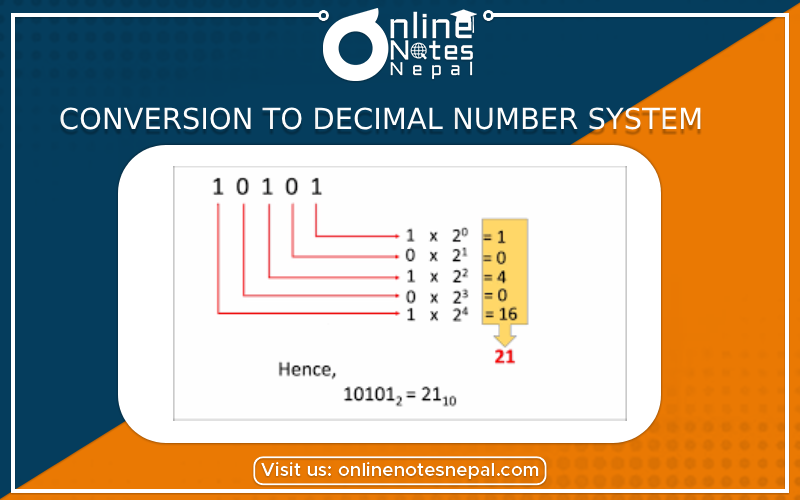Published by: Sujan
Published date: 18 Jun 2021

As we can convert the decimal number system to any number system, we also can convert any other number system to decimal number system.
Conversion to Decimal Number System can be studied in the following topics;
Now we discuss the reverse method, i.e., the method of conversion of binary, octal, or hexadecimal numbers to decimal numbers. Now we have to keep in mind that each of the binary, octal, or hexadecimal number system is a positional number system, i.e., each of the digits in the number systems discussed above has a positional weight as in the case of the decimal system. We illustrate the process with the help of examples.
Example: Convert (10110)2 into a decimal number.
Solution: The binary number given is 1 0 1 1 0
Positional weights 4 3 2 1 0
The positional weights for each of the digits are written in italics below each digit. Hence the decimal equivalent number is given as:
1 × 24 + 0 × 23 + 1 × 22 + 1 × 21 + 0 × 20
= 16 + 0 + 4 + 2 + 0
= (22)10.
Hence we find that here, for the sake of conversion, we have to multiply each bit with its positional weights depending on the base of the number system.
We can understand this conversion with the help of the following example;
Example: Convert (3468)8 into a decimal number.
Solution: The octal number given is 3 4 6 2
Positional weights 3 2 1 0
The positional weights for each of the digits are written in italics below each digit. Hence the decimal equivalent number is given as:
3 × 83 + 4 × 82 + 6 × 81 + 2 × 80
= 1536 + 256 + 48 + 2
= (1842)10.
Example: Convert (42AD)16 into a decimal number.
Solution: The hexadecimal number given is 4 2 A D
Positional weights 3 2 1 0
The positional weights for each of the digits are written in italics below each digit. Hence the decimal equivalent number is given as:
4 × 163 + 2 × 162 + 10 × 161 + 13 × 160
= 16384 + 512 + 160 + 13
= (17069)10.